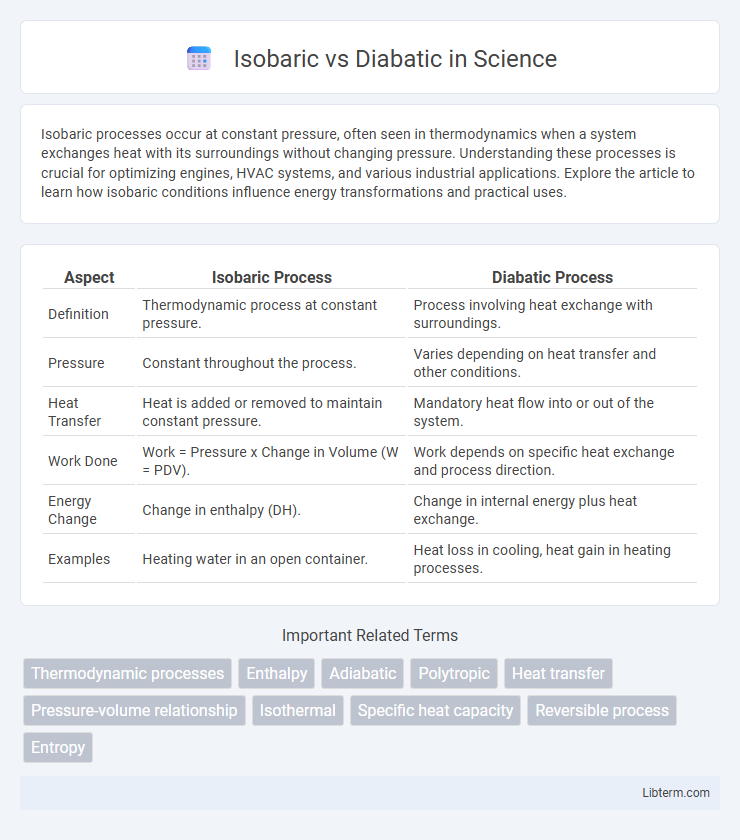Isobaric processes occur at constant pressure, often seen in thermodynamics when a system exchanges heat with its surroundings without changing pressure. Understanding these processes is crucial for optimizing engines, HVAC systems, and various industrial applications. Explore the article to learn how isobaric conditions influence energy transformations and practical uses.
Table of Comparison
| Aspect | Isobaric Process | Diabatic Process |
|---|---|---|
| Definition | Thermodynamic process at constant pressure. | Process involving heat exchange with surroundings. |
| Pressure | Constant throughout the process. | Varies depending on heat transfer and other conditions. |
| Heat Transfer | Heat is added or removed to maintain constant pressure. | Mandatory heat flow into or out of the system. |
| Work Done | Work = Pressure x Change in Volume (W = PDV). | Work depends on specific heat exchange and process direction. |
| Energy Change | Change in enthalpy (DH). | Change in internal energy plus heat exchange. |
| Examples | Heating water in an open container. | Heat loss in cooling, heat gain in heating processes. |
Introduction to Isobaric and Diabatic Processes
Isobaric processes occur at constant pressure, allowing volume and temperature to change while the system exchanges heat with the surroundings, commonly observed in piston-cylinder devices and atmospheric phenomena. Diabatic processes involve heat transfer across the system boundary, altering thermal energy and entropy, essential in meteorology for cloud formation and weather patterns. Understanding these fundamental thermodynamic processes enables analysis of energy exchange mechanisms in engineering and environmental systems.
Defining Isobaric Processes
Isobaric processes occur at constant pressure, where the system's pressure remains unchanged throughout the transformation. During an isobaric process, the volume of the substance varies, leading to work done by or on the system as heat is absorbed or released. This type of process is commonly observed in thermodynamics involving gases, such as in piston engines or atmospheric phenomena.
Understanding Diabatic Processes
Diabatic processes involve heat transfer between a system and its surroundings, causing changes in internal energy independent of pressure variations. Unlike isobaric processes, which occur at constant pressure, diabatic processes can lead to temperature shifts due to heat exchange, critical in atmospheric dynamics and thermodynamic cycles. Understanding diabatic effects is essential in modeling weather patterns, climate systems, and energy transfer in engineering applications.
Key Differences Between Isobaric and Diabatic
Isobaric processes occur at constant pressure, making them critical in understanding phase changes and heat transfer in atmospheric sciences and thermodynamics. Diabatic processes involve heat exchange with the surroundings, affecting temperature and energy balance in weather systems and climate models. The key difference lies in constant pressure for isobaric versus heat flow for diabatic, influencing how each process impacts temperature and enthalpy changes.
Thermodynamic Implications
Isobaric processes involve constant pressure conditions leading to changes in volume and enthalpy, affecting system work output and heat transfer efficiency in thermodynamic cycles. Diabatic processes incorporate heat exchange with surroundings, altering internal energy and entropy, which impacts the irreversibility and efficiency of thermal systems. Understanding these processes is crucial for optimizing energy conversion and managing thermodynamic properties in engineering applications.
Practical Examples in Real-World Applications
Isobaric processes, where pressure remains constant, are commonly observed in cooking methods such as boiling water, where the temperature changes without altering pressure. Diabatic processes involve heat exchange, evident in refrigeration cycles where heat is transferred out of the system to cool an environment. Understanding these processes enhances efficiency in engineering applications like HVAC systems and internal combustion engines, where managing heat and pressure is crucial.
Energy Transfer and Heat Exchange
Isobaric processes involve energy transfer primarily as heat exchange at constant pressure, allowing the system to perform work while changing volume. Diabatic processes emphasize heat transfer with the environment, resulting in a change of internal energy without the restriction of constant pressure or volume. The key distinction lies in isobaric maintaining steady pressure during heat transfer, whereas diabatic refers broadly to any process involving heat exchange, affecting temperature and phase changes.
Role in Atmospheric and Engineering Systems
Isobaric processes, characterized by constant pressure, significantly influence atmospheric phenomena such as weather patterns and heat exchange in engineering systems like HVAC units and combustion engines. Diabatic processes involve heat transfer that alters temperature and internal energy, impacting atmospheric convection and energy efficiency in heat exchangers and turbines. Understanding the distinction between isobaric and diabatic mechanisms is crucial for optimizing thermal management and predicting dynamic environmental changes in both natural and engineered contexts.
Advantages and Limitations
Isobaric processes maintain constant pressure, allowing for easier control of volume and temperature changes in practical applications such as heating and cooling systems, but they can result in energy losses due to work done by expanding or compressing fluids. Diabatic processes involve heat exchange with the surroundings, enabling accurate energy transfer modeling in heat exchangers and thermodynamic cycles, yet they can be complex to analyze due to varying temperature gradients and non-ideal heat transfer. Both processes play critical roles in thermodynamics, with isobaric offering simplicity and diabatic providing precise heat interaction modeling.
Summary and Final Comparison
Isobaric processes occur at constant pressure, allowing volume and temperature changes, commonly seen in atmospheric and engineering applications, while diabatic processes involve heat exchange with the surroundings, impacting system energy and temperature. In thermodynamics, isobaric conditions simplify analysis by maintaining pressure, whereas diabatic interactions account for real-world heat transfer effects. Understanding their differences is essential for accurate modeling of thermodynamic cycles, climate systems, and energy transfer applications.
Isobaric Infographic

 libterm.com
libterm.com